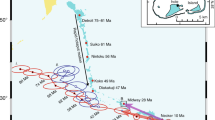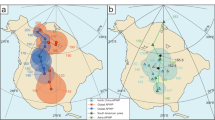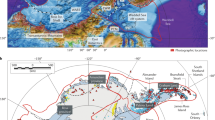Abstract
VIRTUAL geomagnetic poles (VGPs) recorded in sediments during reversals of the Earth's magnetic field show an apparent preference for two antipodal sectors of longitude1–3, not only in records of the same reversal from different sites, but also in records of different reversals. If preferred bands really have persisted from one reversal to the next, this would imply that the mantle exerts a significant control over the reversal process4. Here we analyse the available database of reversal records from the past 12 Myr, using a statistical test specifically designed to test the hypothesis of two preferred antipodal longitudinal bands. Our analysis shows that the records, taken as a group of independent observations, do show an overall preference for two antipodal longitudinal bands. However, the site longitudes are also strongly grouped5, and a comparison of the transitional VGP longitudes with site longitudes shows an unlikely grouping under the hypothesis of a genuine geographical preference for transitional VGPs. We conclude that it is premature to accept the hypothesis of mantle control over the core during geomagnetic reversals.
This is a preview of subscription content, access via your institution
Access options
Subscribe to this journal
Receive 51 print issues and online access
$199.00 per year
only $3.90 per issue
Buy this article
- Purchase on Springer Link
- Instant access to full article PDF
Prices may be subject to local taxes which are calculated during checkout
Similar content being viewed by others
References
Tric, E. et al. Phys. Earth planet int. 65, 319–336 (1991).
Gubbins, D. Eos 72, 132 (1991).
Clement, B. M. & Kent, D. V. Geophys. Res. Lett. 18, 81–84 (1991).
Laj, C. et al. Nature 351, 447 (1991).
Valet, J.-P., Tucholka, P., Courtillot, V. & Meynadier, L. Nature 356, 400–407 (1992).
Laj, C. et al. Geophys. Res. Lett. 19, 2003–2006 (1992).
Laj,, C. et al. Nature 359, 111–112 (1992).
Mardia, K. V. Statistics of Directional Data (Academic, London, 1972).
Rothman, E. D. Sankhya A34, 23–32 (1972).
Egbert, G. Geophys. Res. Lett. 19, 2353–2356 (1992).
Hoffman, K. A. Nature 359, 789–794 (1992).
Constable, C. Nature 358, 230–233 (1992).
Barton, C. E. et al. Geophys. J. R. astr. Soc. 61, 355–377 (1980).
Author information
Authors and Affiliations
Rights and permissions
About this article
Cite this article
McFadden, P., Barton, C. & Merrill, R. Do virtual geomagnetic poles follow preferred paths during geomagnetic reversals?. Nature 361, 342–344 (1993). https://doi.org/10.1038/361342a0
Received:
Accepted:
Issue Date:
DOI: https://doi.org/10.1038/361342a0
This article is cited by
-
A representation function for a distribution of points on the unit sphere—with applications to analyses of the distribution of virtual geomagnetic poles
Earth, Planets and Space (2014)
-
The Magnetic Field of Planet Earth
Space Science Reviews (2010)
-
High-resolution evidence for dynamic transitional geomagnetic field behaviour from a Miocene reversal, McMurdo Sound, Ross Sea, Antarctica
Earth, Planets and Space (2007)
-
A Brunhes-Matuyama polarity transition record from anoxic sediments in the South Atlantic (Ocean Drilling Program Hole 1082C)
Earth, Planets and Space (2001)
-
The role of the Earth's mantle in controlling the frequency of geomagnetic reversals
Nature (1999)
Comments
By submitting a comment you agree to abide by our Terms and Community Guidelines. If you find something abusive or that does not comply with our terms or guidelines please flag it as inappropriate.



